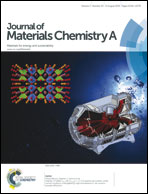A general strategy of decorating 3D carbon nanofiber aerogels derived from bacterial cellulose with nano-Fe3O4 for high-performance flexible and binder-free lithium-ion battery anodes†
Abstract
Flexible, binder-free, and cost-effective materials have been highly sought-after in the development of next generation electrodes. Herein, we report a general, scalable, and eco-friendly synthesis of a novel flexible nano-Fe3O4-decorated three-dimensional (3D) carbon nanofiber (CNF) aerogel derived from bacterial cellulose (BC) (named Fe3O4-BC-CNFs) via a hydrothermal approach followed by carbonization. The as-prepared Fe3O4-BC-CNF electrodes with optimal Fe3O4 loading exhibit greatly improved electrochemical performance over bare BC-CNFs and Fe3O4 nanoparticles. Furthermore, compared with most of the other relevant types of electrodes, the flexible and binder-free Fe3O4-BC-CNF electrodes can deliver a higher reversible capacity of 754 mA h g−1 (after 100 cycles at 100 mA g−1). The excellent electrochemical performance is ascribed to the highly dispersed Fe3O4 nanoparticles on CNFs, the 3D porous structure, large surface area, and the interconnected CNFs, which offer a large material/electrolyte contact area, promote a high diffusion rate of Li ions, and accommodate volume changes of the active materials during cycling. The excellent flexibility and high reversible capacity of the electrodes as well as the eco-friendly and scalable process make them promising for the development of flexible energy-storage devices.

- This article is part of the themed collection: 2015 Journal of Materials Chemistry A Hot Papers

 Please wait while we load your content...
Please wait while we load your content...